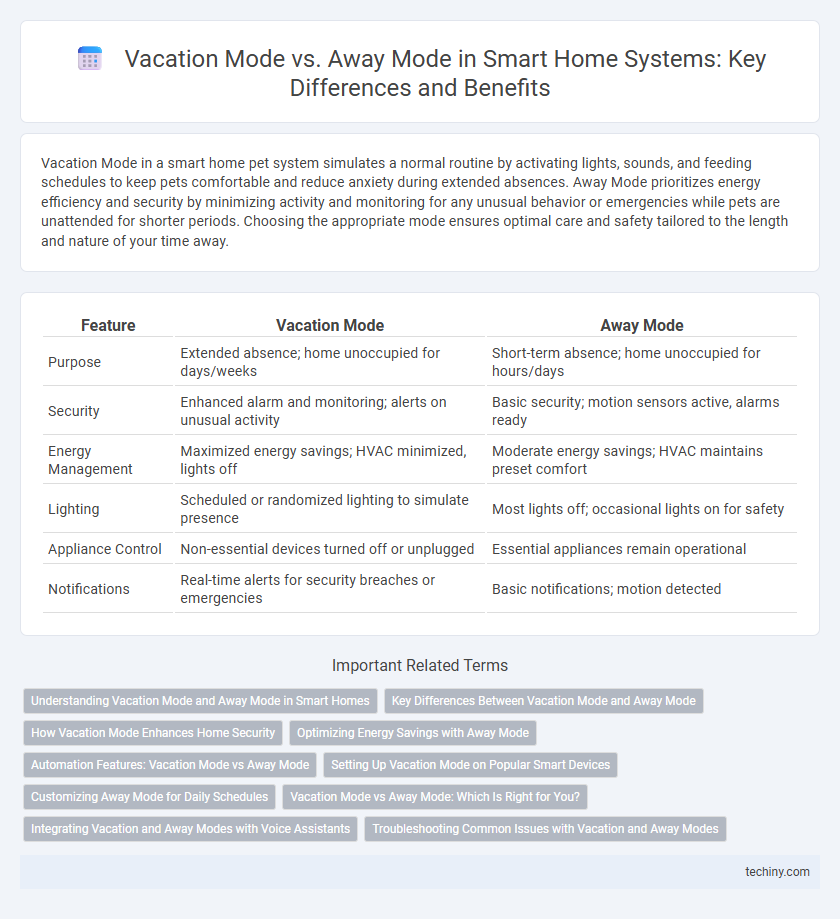Vacation Mode in a smart home pet system simulates a normal routine by activating lights, sounds, and feeding schedules to keep pets comfortable and reduce anxiety during extended absences. Away Mode prioritizes energy efficiency and security by minimizing activity and monitoring for any unusual behavior or emergencies while pets are unattended for shorter periods. Choosing the appropriate mode ensures optimal care and safety tailored to the length and nature of your time away.
Table of Comparison
| Feature | Vacation Mode | Away Mode |
|---|---|---|
| Purpose | Extended absence; home unoccupied for days/weeks | Short-term absence; home unoccupied for hours/days |
| Security | Enhanced alarm and monitoring; alerts on unusual activity | Basic security; motion sensors active, alarms ready |
| Energy Management | Maximized energy savings; HVAC minimized, lights off | Moderate energy savings; HVAC maintains preset comfort |
| Lighting | Scheduled or randomized lighting to simulate presence | Most lights off; occasional lights on for safety |
| Appliance Control | Non-essential devices turned off or unplugged | Essential appliances remain operational |
| Notifications | Real-time alerts for security breaches or emergencies | Basic notifications; motion detected |
Understanding Vacation Mode and Away Mode in Smart Homes
Vacation Mode and Away Mode in smart homes optimize security and energy efficiency by tailoring device settings based on homeowner absence duration and activity. Vacation Mode typically extends over longer periods, activating features like randomized lighting and thermostat adjustments to simulate occupancy and save energy. Away Mode usually caters to shorter absences, focusing on essential security alarms and minimal energy use without the occupancy simulation features.
Key Differences Between Vacation Mode and Away Mode
Vacation Mode in a smart home system typically simulates occupancy by adjusting lighting, blinds, and sound devices on a schedule to deter intruders, whereas Away Mode primarily focuses on security by activating alarms and locking doors without simulating presence. Vacation Mode integrates energy-saving features by minimizing HVAC usage while maintaining essential functions, contrasting with Away Mode's emphasis on maintaining a strict security perimeter. The key difference lies in Vacation Mode's blend of security, energy management, and comfort simulation, compared to Away Mode's sole prioritization of home protection during short absences.
How Vacation Mode Enhances Home Security
Vacation Mode enhances home security by simulating occupancy through automated lighting, blinds, and appliance schedules, deterring potential intruders. It integrates with security cameras and alarms to provide real-time alerts and remote monitoring, ensuring continuous surveillance. Unlike Away Mode, Vacation Mode offers a comprehensive security ecosystem that mimics daily home activity for extended periods.
Optimizing Energy Savings with Away Mode
Away Mode significantly optimizes energy savings by mimicking occupancy through randomized lighting and appliance schedules, deterring potential intruders while reducing unnecessary power consumption. Unlike Vacation Mode, which typically powers down most systems for extended absences, Away Mode maintains minimal activity to prevent energy waste without compromising home security. Smart thermostats integrated with Away Mode dynamically adjust heating and cooling to lower energy use during absence, delivering effective cost savings and increased efficiency.
Automation Features: Vacation Mode vs Away Mode
Vacation Mode automates home settings by simulating occupancy through scheduled lighting, temperature adjustments, and security system activation to enhance safety during extended absences. Away Mode focuses on energy efficiency by reducing power consumption, adjusting thermostats, and disabling non-essential devices while maintaining basic security monitoring. Both modes integrate with smart home automation systems but differ in prioritizing either security simulation or energy savings.
Setting Up Vacation Mode on Popular Smart Devices
Setting up Vacation Mode on popular smart devices like Google Nest, Amazon Alexa, and Samsung SmartThings involves enabling energy-saving features, adjusting thermostat settings, and scheduling automated lighting to simulate occupancy. Google Nest allows users to activate Eco Temperatures to reduce energy use while away, whereas Amazon Alexa offers routines to control smart plugs and lights remotely. Samsung SmartThings provides customizable vacation modes that integrate multiple smart appliances, ensuring security and efficiency throughout extended absences.
Customizing Away Mode for Daily Schedules
Customizing Away Mode in smart home systems allows users to tailor security and energy-saving settings based on daily routines, enhancing convenience and efficiency. Unlike Vacation Mode, which applies a prolonged, static configuration for extended absences, Away Mode adapts dynamically to shorter periods such as work hours or errands. Integrating features like adjustable lighting, thermostat control, and security alerts ensures personalized automation that aligns with everyday schedules.
Vacation Mode vs Away Mode: Which Is Right for You?
Vacation Mode in smart homes maximizes security by simulating occupancy through automated lighting, blinds, and sound systems, ideal for extended absences. Away Mode optimizes energy savings by adjusting thermostats, locking doors, and turning off non-essential devices, perfect for short trips or daily routines. Choosing between Vacation Mode and Away Mode depends on your absence duration and desired home automation features for security versus energy efficiency.
Integrating Vacation and Away Modes with Voice Assistants
Vacation Mode and Away Mode can be seamlessly integrated with voice assistants like Amazon Alexa, Google Assistant, and Apple HomeKit to enhance smart home automation. Voice commands enable users to activate specific settings such as adjusting thermostats, enabling security cameras, and controlling lighting to simulate occupancy and conserve energy. This integration boosts convenience and security by allowing remote management and real-time status updates through natural language interaction.
Troubleshooting Common Issues with Vacation and Away Modes
Troubleshooting common issues with Vacation Mode and Away Mode in smart home systems involves verifying sensor connectivity and ensuring correct automation settings are applied. Many problems arise from misconfigured geofencing parameters or outdated firmware, which can cause modes to fail activating or deactivating as expected. Regularly updating the smart home hub software and calibrating motion detectors resolves most functionality lapses in these modes.
Vacation Mode vs Away Mode Infographic

 techiny.com
techiny.com